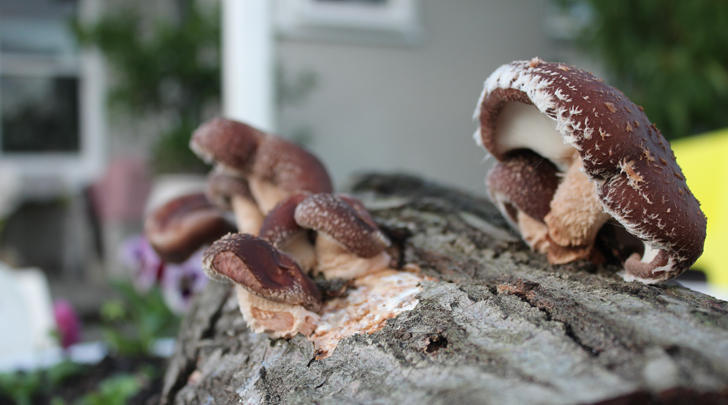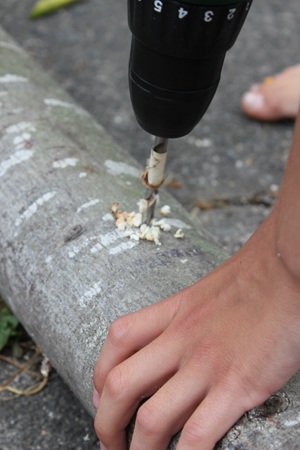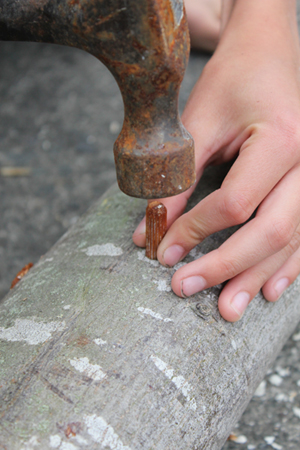Gardening guides
How to grow shiitake mushrooms with dowel spawn
Janet Luke

Shiitake mushrooms are slightly more challenging to grow than oyster mushrooms, but if you follow a simple process you will still be ensured success. Shiitake mushrooms will only grow on wood from a variety of tree species. To begin your shiitake growing you need to obtain shiitake cultures which have inoculated wooden dowels. These dowels are small round plugs of wood which have the spawn growing on them. You can get these from mushroom spawn suppliers such as www.mushroomgourmet.co.nz. Once ordered these dowels will arrive (often in the post) wrapped in cotton wool and in plastic bags. They can be kept in the fridge for up to three months until required.
Which wood?
Selecting the best available tree species is the first step to successfully growing shiitake. The logs are best harvested in late winter or early spring, before bud burst. When the tree is dormant the wood contains the maximum amount of stored carbohydrate, which will become food for the developing mushrooms. Choose logs which don’t have any signs of disease or decay and have their bark intact. Log lengths are not important but choose logs with a diameter of between 10cm and 30cm.
Types of trees to use
- Oak
- Chestnut
- Alder
- Poplar
- Beech
- Birch
- Elm
- Sweetgum
- Willow
- Nut trees
Don’t use
- Pine
- Macrocarpa
- Eucalyptus
- Cyprus
These trees have too much resin in their wood, which stops the mushrooms growing.
Inoculating your logs
Equipment required
- Cordless drill
- Drill bit the same diameter as the wooden dowels
- Black felt pen
- Masking tape
- Beeswax candle
- Lighter
- Tarpaulin
- Tape measure
- Hammer
Method
- Keeping all bark intact, scrape off any pieces of lichen.
- Trim the logs to around 50cm with a saw.
-
Measure the length of your wooden dowels and wrap a length of masking tape at that measurement on your drill bit. This will give you a guide on how deep to drill each hole prior to inserting dowels in the holes.

- On each log mark 5cm down from the top, then 15cm, 25cm, 35cm and 45cm. For the smaller diameter logs, drill four equally spaced holes at each of these levels. For larger logs, drill five holes at each level.
-
Wash your hands well with soap and hot water.

- Insert the dowels into each hole. You may need to give them a light tap with the hammer. The hole should be a snug fit for the dowel.
- Seal the top of the hole with some melted beeswax from the candle. This seals the hole, preventing any other fungi or bacteria entering.
- Place your inoculated logs on top of the tarp in a cool, shady area. Stack them loosely together. You can lightly cover the top of the logs with the rest of the tarp if you wish. Under a tree or hedge is good.
- Check moisture levels occasionally. You may need to splash some water on your logs to keep them moist. The optimum situation is when the bark remains dry but the wood remains damp.
When can I harvest?
The shiitake fungus needs to colonise the entire log. After several months you may see white threads snaking through some of the wood. Don’t let the logs dry out.
The length of time required for mycelium to grow through the log will vary from 6-18 months depending upon spawn type, environmental conditions, the size of the log and the timber used. The mycelium may first be seen as V-shaped markings at the ends of the log.
The first ‘fruiting’ will normally occur from 6-18 months after inoculation. Normally fruiting occurs in spring and autumn but you can extend this over winter if you bring your log inside. When logs are at this age I lean them up against a wall or fence line so that all the surface of the log is exposed. Do not place the logs flat on the ground.
The production of mushrooms can be encouraged by soaking the logs in fresh rain water for 24 hours. Often a flush of mushrooms will follow this. Logs can keep fruiting for up to six years so look after them well.
To harvest the mushrooms, twist the stem carefully from the bark.
Shitake mushrooms
This Asian delicacy is native to Japan, China and Korea. They are chewy, aromatic and more flavourful than button mushrooms and have a dark-brown cap with white gills. They prefer to grow on wood singly or in small groups. They will grow in a wide range of temperatures from just above freezing to 32°C.
